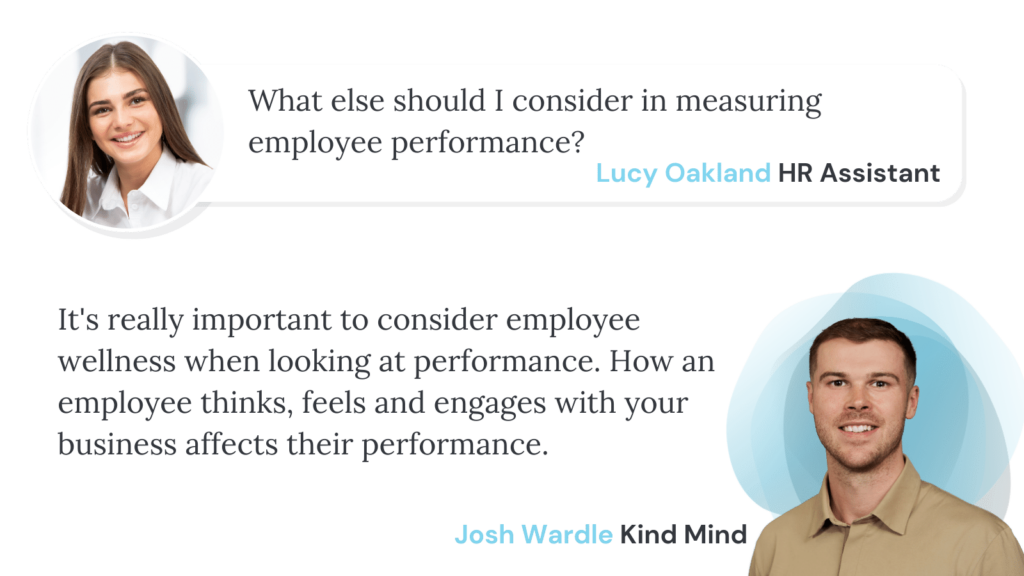We set goals for our business growth at the beginning of each year. In doing so, we predetermine how well our staff need to perform. But how do we measure employee performance effectively to move towards the goal line?
In this Kind Mind guide, we will take you through everything you need to know about creating performance programs and benchmarks to help you and your staff achieve more.
What is employee performance?
Employee performance refers to how well an employee executes the tasks and responsibilities within their role at a company. It encompasses a variety of factors, including productivity, quality of work, ability to meet deadlines, work collaboratively with others, communicate effectively and adhere to company policies and procedures.
Employers often measure employee performance through regular performance reviews or evaluations, which can include a combination of objective metrics such as sales figures or the number of projects completed as well as subjective assessments of skills and behaviour.
The goal of measuring employee performance is to identify areas where an employee excels and areas where improvement is needed to help them grow and contribute more effectively to the company.
Why you should measure employee performance
There are several reasons why measuring your employees’ performance is vital. These include:
- To provide feedback and support for employee growth – Measuring employee performance allows you to offer constructive feedback to employees on their strengths and areas for improvement. This helps employees understand what is expected of them and how they can develop their skills to be more effective in their role.
- Identifying and rewarding high performers – can include bonuses, promotions, or other incentives to motivate employees to continue performing well.
- To identify resource and training requirements – Measuring employee performance can help you identify areas where employees are struggling or where additional training or resources may be needed to help them perform more effectively.
- To align individual and company goals – This helps create a more cohesive and productive workforce focused on growth and innovation.
- To improve overall company performance – Measuring employee performance can help you identify areas where overall performance can be improved, leading to greater efficiency and profitability.

How often should you measure employee performance?
The frequency of measuring employee performance depends on several factors, such as the nature of employees’ jobs, the goals of the company, and the industry. However, here are some general processes that help you measure performance.
Regular check-ins
Regular check-ins between employees and their managers can be done weekly or biweekly to discuss progress towards goals, any challenges and provide feedback.
Quarterly reviews
Quarterly reviews are a common practice where an employee’s performance is evaluated against the objectives and goals set at the beginning of the quarter.
Annual performance reviews
Many companies conduct annual performance reviews to evaluate an employee’s performance and set new goals for the upcoming year.
Project-based evaluations
Employees who work on specific projects can be evaluated at the end of each project. This can help indicate changes in engagement or the need for further training.
Continuous evaluation
Continuous evaluation involves providing ongoing feedback and coaching to employees throughout the year. This approach is becoming increasingly popular as it provides employees with regular feedback and allows for timely course correction.
Remember, how and when you choose to evaluate staff performance is also about being flexible enough to adapt to changing circumstances. For example, individual and social situations may demand more frequent reviews for individuals or teams.
How to measure, monitor and improve employee performance
Measuring employee performance involves evaluating employee productivity, work quality, and overall effectiveness in their role. Here are some steps to consider when measuring employee performance:
- Establish clear job expectations – Before measuring your employee’s performance, it’s crucial to establish clear job expectations. This includes defining job responsibilities, performance standards, and goals.
- Set measurable performance metrics – Determine critical metrics that can be used to measure an employee’s performance objectively. For example, if the employee is in a sales role, metrics may include the number of sales closed or the revenue generated.
- Communicate employee goals clearly – Ensure employees understand what is expected of them and how this contributes to the bigger picture.
- Schedule regular performance reviews – Schedule regular performance reviews to evaluate an employee’s progress towards their goals and to provide feedback on their performance.
- Use a performance evaluation tool – Use a performance evaluation tool, such as a rating scale or performance appraisal form, to assess an employee’s performance against established metrics and job expectations. This can provide a more objective evaluation of an employee’s work.
- Provide feedback and coaching – After evaluating an employee’s performance, provide feedback and coaching on areas where they excel and need improvement. This can help the employee continue to grow and develop in their role.
- Recognise and reward top performers – Recognise and reward top performers to motivate them to continue performing at a high level. This can include bonuses, promotions, or other incentives.
- Get ready to motivate every employee – It isn’t enough to demand high employee performance alone; you must provide motivation where it is needed. This goes beyond reward systems and comes from the heart of a positive work culture; your employees’ experience.
- Develop performance improvement plans – If an employee is not meeting expectations, develop a performance improvement plan that outlines specific actions that the employee can take to improve their execution.
Overall, measuring employee performance requires a combination of objective metrics and subjective evaluations to provide a comprehensive view of your employee’s effectiveness in their role.
Is there an employee performance formula for measurement?
There is no single formula for measuring employee performance; however, here are a few common methods and formulas that can be used.
Key Performance Indicators (KPIs)
These indicate how well your employees achieve their primary objectives. Examples include the number of sales made, customer satisfaction scores, or the number of projects completed on time.
Here are some common employee performance KPIs to help you get started in your HR work.
- Sales targets – This KPI measures the number of sales an employee makes within a specific timeframe.
- Customer satisfaction – This KPI measures customers’ satisfaction with an employee’s performance. This can be measured through surveys, feedback, or ratings.
- Attendance and punctuality – Tracking systems, such as time and attendance software, can measure this.
- Quality of work – This can be measured through quality control processes, audits, or customer feedback.
- Productivity – This KPI measures an employee’s productivity, such as the number of tasks completed or the amount of work produced within a specific timeframe.
- Efficiency – This KPI measures an employee’s efficiency in completing tasks, such as reducing the time or resources needed to complete a task.
- Goal completion – Measuring an employee’s ability to achieve specific goals or objectives within a given timeframe.
- Teamwork – This KPI measures an employee’s ability to work effectively with others and contribute to a positive team dynamic.
- Learning and development – Measuring an employee’s progress in developing new skills or knowledge relevant to their job.
Management by Objectives (MBO)
MBO sets specific objectives for employees and then evaluates their performance against those objectives. It involves establishing specific, measurable, achievable, relevant, and time-bound (SMART) goals.
An example SMART goal for an employee is “By the end of the quarter, the employee will increase their sales by 15% by implementing new sales techniques and expanding their customer base.”
360-degree feedback
This involves gathering employee performance feedback from various sources, including managers, peers, and subordinates. This can provide a more well-rounded view of your employee’s performance and help identify improvement areas.
Behavioural Observation Scales (BOS)
BOS measures the frequency or severity of specific behaviours related to job performance. This involves identifying specific behaviours critical for job success and rating your employee’s performance.
Productivity Metrics
These include the number of units produced, customers served, or the time spent on a task. These metrics are used to measure your employee’s output and productivity levels.
It’s important to note that each of these methods and formulas has its strengths and limitations, and it’s essential to select the appropriate method based on your company’s specific needs and goals. It’s also critical to test what is achievable in your business setting. Benchmarking, in this way, helps you create meaningful expectations.
What to consider when setting employee performance benchmarks
While benchmarking employee performance can provide valuable insights into an individual’s strengths and weaknesses, relying too heavily on this approach can have several pitfalls. Firstly, it can create an environment of intense competition and pressure to meet unrealistic targets, leading to burnout and high turnover rates.
Additionally, strictly adhering to benchmarks can stifle innovation and creativity, as employees may become overly focused on meeting predetermined metrics instead of experimenting with new ideas and approaches.
Furthermore, benchmarking needs to consider each employee’s job’s unique circumstances and challenges, such as market changes or technological advancements.
A more holistic approach to performance evaluation, which considers individual strengths, goals, and development areas, will likely foster a positive and productive work environment.
Remember that improving employee performance is an ongoing process that requires effort and communication between the employee and the manager. Take your time, involve your staff and monitor your progress.
Good luck.
Are you looking for more guides on HR benchmarks? Read our latest articles here.






